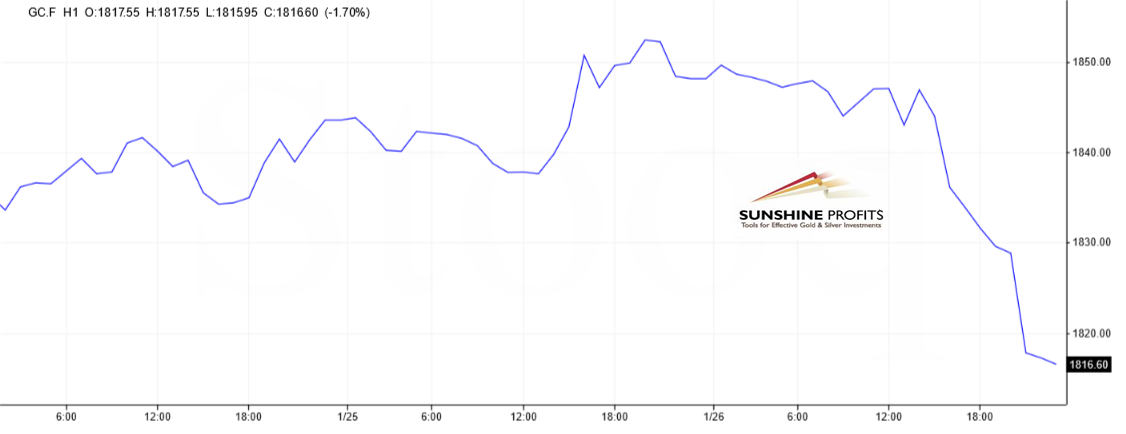The FOMC set the stage for a March interest rate hike, which was an aggressive signal. Gold got it and fell – but hasn’t capitulated yet.
 Bullion.Directory precious metals analysis 27 January, 2022
Bullion.Directory precious metals analysis 27 January, 2022
By Arkadiusz Sieroń, PhD
Lead Economist and Overview Editor at Sunshine Profits
With inflation well above 2 percent and a strong labor market, the Committee expects it will soon be appropriate to raise the target range for the federal funds rate.
Previously, the US central bank conditioned its tightening cycle on the situation in the labor market. The relevant part of the statement was as follows in December:
With inflation having exceeded 2 percent for some time, the Committee expects it will be appropriate to maintain this target range until labor market conditions have reached levels consistent with the Committee’s assessments of maximum employment.
The alteration implies that, in the Fed’s view, the US economy has reached maximum employment and is ready to lift the federal funds rate. Indeed, Powell reaffirmed it, saying:
There’s quite a bit of room to raise interests without threatening the labor market. This is by so many measures a historically tight labor market — record levels of job openings, quits, wages are moving up at the highest pace they have in decades.
Powell also clarified the timing, stating that “the Committee is of the mind to raise the federal funds rate at the March meeting.” This is not completely unexpected, but does mark a significant hawkish change in the Fed’s communication, which is negative for gold.
Second, the FOMC reaffirmed its plan, announced in December, to end quantitative easing in early March. It means that in February, the Fed will buy only $20 billion of Treasuries and $10 billion of agency mortgage-backed securities, instead of the $40 and $20 purchased in January:
The Committee decided to continue to reduce the monthly pace of its net asset purchases, bringing them to an end in early March. Beginning in February, the Committee will increase its holdings of Treasury securities by at least $20 billion per month and of agency mortgage‑backed securities by at least $10 billion per month.
Third, the FOMC is preparing for quantitative tightening. Together with the statement on monetary policy, it published “Principles for Reducing the Size of the Federal Reserve’s Balance Sheet”. The Fed hasn’t yet determined the timing and pace of reducing the size of its mammoth balance sheet.
However, we know that it will happen after the first hike in interest rates, so probably as soon as May or June. After all, as Powell admitted during his press conference, “the balance sheet is substantially larger than it needs to be (…). There’s a substantial amount of shrinkage in the balance sheet to be done.”
Implications for Gold
What does the recent FOMC statement imply for the gold market? The end of QE, the start of the hiking cycle, and then of QT – all packed within just a few months – is a big hawkish wave that could sink the gold bulls. The Fed hasn’t been so aggressive for years.
Of course, maybe it’s just a great bluff, and the Fed will retreat to its traditional dovish stance soon when tightening monetary and financial conditions hit Wall Street and the real economy. However, with CPI inflation above 7%, mounting political pressure, and public outrage at costs of living, the US central bank has no choice but to tighten monetary policy, at least for the time being.
It seems that gold got the message. The price of the yellow metal plunged more than $30 yesterday, as the chart below shows. Interestingly, gold started its decline before the statement was published, which may indicate more structural weakness. What is also disturbing is that gold was hit even though the FOMC statement came largely as expected.

On the other hand, gold didn’t collapse, but it dropped only by thirty-some dollars, or about 1.6%. Given the importance and hawkishness of the FOMC meeting, it could have been worse. Yes, the hawkish message was expected, and some analysts even forecasted more aggressive actions, but gold clearly didn’t capitulate.
Thus, there is hope (and turbulence in the stock market can also help here), although the upcoming weeks may be challenging for gold, which would have to deal with rising bond yields.
Arkadiusz Sieroń


Arkadiusz Sieroń – is a certified Investment Adviser, long-time precious metals market enthusiast, Ph.D. candidate and a free market advocate who believes in the power of peaceful and voluntary cooperation of people.
He is an economist and board member at the Polish Mises Institute think tank, a Laureate of the 6th International Vernon Smith Prize and the author of Sunshine Profits’ bi-weekly Fundamental Gold Report and monthly Gold Market Overview.
This article was originally published here











 Material provided on the Bullion.Directory website is strictly for informational purposes only. The content is developed from sources believed to be providing accurate information. No information on this website is intended as investment, tax or legal advice and must not be relied upon as such. Please consult legal or tax professionals for specific information regarding your individual situation. Precious metals carry risk and investors requiring advice should always consult a properly qualified advisor. Bullion.Directory, it's staff or affiliates do not accept any liability for loss, damages, or loss of profit resulting from readers investment decisions.
Material provided on the Bullion.Directory website is strictly for informational purposes only. The content is developed from sources believed to be providing accurate information. No information on this website is intended as investment, tax or legal advice and must not be relied upon as such. Please consult legal or tax professionals for specific information regarding your individual situation. Precious metals carry risk and investors requiring advice should always consult a properly qualified advisor. Bullion.Directory, it's staff or affiliates do not accept any liability for loss, damages, or loss of profit resulting from readers investment decisions.

Leave a Reply